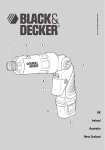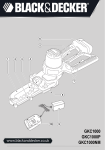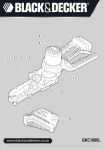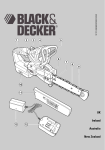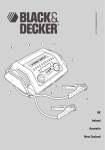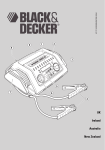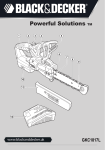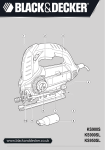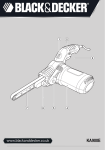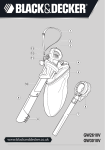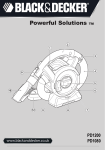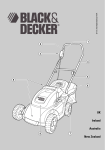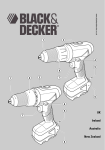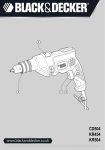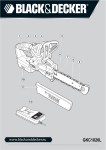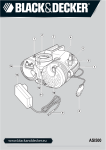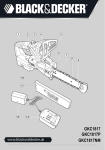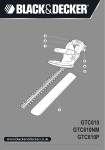Download Alligator GKC1000 UK.book
Transcript
UK Ireland Australia New Zealand 2 3 4 5 6 L 7 Intended use ENGLISH Your Black & Decker AlligatorTM Lopper has been designed for trimming the branches of trees, cutting fallen branches and cutting small logs 25 mm to 100 mm in diameter while the operator is standing on the ground. This tool is intended for consumer use only. General safety rules Warning! Read all safety warnings and all instructions. Failure to follow all instructions may result in electric shock, fire and/or serious injury. ! SAVE ALL WARNINGS AND INSTRUCTIONS FOR FUTURE REFERENCE. The term "power tool" in all of the warnings listed below refers to your mains operated (corded) power tool or battery operated (cordless) power tool. 1. Work area safety a. Keep work area clean and well lit. Cluttered and dark areas invite accidents. b. Do not operate power tools in explosive atmospheres, such as in the presence of flammable liquids, gases or dust. Power tools create sparks which may ignite the dust or fumes. c. Keep children and bystanders away while operating a power tool. Distractions can cause you to lose control. 2. Electrical safety a. Power tool plugs must match the outlet. Never modify the plug in any way. Do not use any adapter plugs with earthed (grounded) power tools. Unmodified plugs and matching outlets will reduce risk of electric shock. b. Avoid body contact with earthed or grounded surfaces such as pipes, radiators, ranges and refrigerators. There is an increased risk of electric shock if your body is earthed or grounded. c. Do not expose power tools to rain or wet conditions. Water entering a power tool will increase the risk of electric shock. d. Do not abuse the cord. Never use the cord for carrying, pulling or unplugging the power tool. Keep cord away from heat, oil, sharp edges or moving parts. Damaged or entangled cords increase the risk of electric shock. e. When operating a power tool outdoors, use an extension cord suitable for outdoor use. Use of a cord suitable for outdoor use reduces the risk of electric shock. f. If operating a power tool in a damp location is unavoidable, use a residual current device (RCD) protected supply. Use of an RCD reduces the risk of electric shock. 8 3. Personal safety a. Stay alert, watch what you are doing and use common sense when operating a power tool. Do not use a power tool while you are tired or under the influence of drugs, alcohol or medication. A moment of inattention while operating power tools may result in serious personal injury. b. Use personal protective equipment. Always wear eye protection. Protective equipment such as dust mask, nonskid safety shoes, hard hat, or hearing protection used for appropriate conditions will reduce personal injuries. c. Prevent unintentional starting. Ensure the switch is in the off-position before connecting to power source and/ or battery pack, picking up or carrying the tool. Carrying power tools with your finger on the switch or energising power tools that have the switch on invites accidents. d. Remove any adjusting key or wrench before turning the power tool on. A wrench or a key left attached to a rotating part of the power tool may result in personal injury. e. Do not overreach. Keep proper footing and balance at all times. This enables better control of the power tool in unexpected situations. f. Dress properly. Do not wear loose clothing or jewellery. Keep your hair, clothing and gloves away from moving parts. Loose clothes, jewellery or long hair can be caught in moving parts. g. If devices are provided for the connection of dust extraction and collection facilities, ensure these are connected and properly used. Use of these devices can reduce dust related hazards 4. Power tool use and care a. Do not force the power tool. Use the correct power tool for your application. The correct power tool will do the job better and safer at the rate for which it was designed. b. Do not use the power tool if the switch does not turn it on and off. Any power tool that cannot be controlled with the switch is dangerous and must be repaired. c. Disconnect the plug from the power source and/or the battery pack from the power tool before making any adjustments, changing accessories, or storing power tools. Such preventive safety measures reduce the risk of starting the power tool accidentally. d. Store idle power tools out of the reach of children and do not allow persons unfamiliar with the power tool or these instructions to operate the power tool. Power tools are dangerous in the hands of untrained users. e. Maintain power tools. Check for misalignment or binding of moving parts, breakage of parts and any other condition that may affect the power tools operation. If damaged, have the power tool repaired before use. Many accidents are caused by poorly maintained power tools. f. Keep cutting tools sharp and clean. Properly maintained cutting tools with sharp cutting edges are less likely to bind and are easier to control. g. Use the power tool, accessories and tool bits etc. in accordance with these instructions, taking into account the working conditions and the work to be performed. Use of the power tool for operations different from those intended could result in a hazardous situation. 5. Battery tool use and care a. Recharge only with the charger specified by the manufacturer. A charger that is suitable for one type of battery pack may create a risk of fire when used with another battery pack. b. Use power tools only with specifically designated battery packs. Use of any other battery packs may create a risk of injury and fire. c. When battery pack is not in use, keep it away from other metal objects like paper clips, coins, keys, nails, screws, or other small metal objects that can make a connection from one terminal to another. Shorting the battery terminals together may cause burns or a fire. d. Under abusive conditions, liquid may be ejected from the battery; avoid contact. If contact accidentally occurs, flush with water. If liquid contacts eyes, additionally seek medical help. Liquid ejected from the battery may cause irritation or burns. 6. Service a. Have your power tool serviced by a qualified repair person using only identical replacement parts. This will ensure that the safety of the power tool is maintained. Additional safety instructions for the AlligatorTM Lopper Warning! Never use the tool above shoulder height. Always position yourself out of the path of falling branches and debris. Warning! Do not use this tool to fell trees. X Keep all parts of your body and clothing away from the saw chain at all times. Hold the tool in front of you and be aware of the saw chain position especially when cutting branches near the ground. Before you switch on make sure the saw chain is not contacting anything. X Pre-plan a safe exit from falling branches and debris. Ensure the exit route is clear of obstacles that would prevent or hinder movement. Remember wet grass and freshly cut bark is slippery. X Be aware of the direction that a branch may fall. Consider all conditions that may affect the direction of fall, including: - The intended direction of fall. - The natural lean of the branch. - Any unusual heavy limb structure or decay. - Surrounding trees and obstacles including overhead lines. X X X X X X X X X X X X X X X X X - The wind speed and direction. The safe distance between a branch and debris to be felled and bystanders, buildings and other objects is at least 2 1/2 times the length of the branch. Any bystander, building or object within this distance is at risk from being struck by the falling branch. When cutting a limb that is under tension, be aware of spring-back. When the tension in the wood fibres are released the spring loaded limb may strike the operator and/or throw the tool out of control. Always wear suitable safety equipment such as non-skid safety shoes, hard hat, goggles, ear protection and gloves when operating the tool. Ensure someone is nearby (at a safe distance) in case of an accident. Do not attempt to operate the tool when in a tree, on a ladder or standing on any other unstable support. Keep proper footing and balance at all times. Hold the tool firmly with both hands when the motor is running. Keep handles dry, clean and free from oil and grease. Greasy oily handles are slippery causing loss of control. Do not let the moving chain contact any object at the tip of the guide bar. Keep your saw chain properly tensioned. Check tension at regular intervals with the motor stopped and cord disconnected. Begin and continue cutting only with the chain moving at full speed. Watch for shifting branches or other forces that could close a cut and pinch or fall into the chain. Use extreme caution when re-entering a previous cut. Engage spikes on lower jaw into wood and allow the chain to reach full speed before proceeding with cut. Use of this tool for operation different to those intended could result in hazardous situations. Cut wood only. Don't use this tool for purposes not intended - for example - Don't use tool for cutting plastic, masonry or non wood building materials. If any debris gets caught with the guard or tool discontinue use, remove the battery and clear debris. Worn chains and chain guide bars should be replaced. Only use replacement bars and chains specified by the manufacturer. 9 Warning symbols KWA (acoustic power uncertainty) 3 dB(A) The following warning symbols are found on your tool: Vibration Read the user manual. Do not use your saw in wet conditions or expose it to rain. Always wear head, hearing and eye protection. Beware of falling objects. Keep bystanders away. Do not use on ladders. Check the chain tension after every 10 minutes of use. Adjust back to a clearance of 3 mm. Oil the chain after every 10 minutes of use. Warning do not touch chain at the chip ejection point. Direction of travel of the chain. Residual risk Despite the application of the relevant safety regulations and the implementation of safety measures, certain residual risks are inherent to the use of wood cutting saws and cannot be avoided. These are: X Risk of injury arising from contact with moving parts, sharp parts, hot parts, branches or debris falling on the operator, bystanders or property, debris ejected by the tool. X Risk of injury arising from un-intended use, falling from a ladder or working position in a tree, damage to the supply cable, use of the tool in wet or hazardous locations, use of the product by young children or infirm persons, failure to wear suitable personal protection or suitable clothing, breathing dust generated from cutting wood. The above risks have been addressed by including warnings in the safety instructions and/or markings applied to the tool. Noise and vibration Information Noise Typical Noise Emissions according to EN60745 LpA (Sound pressure) 81 dB(A) LwA (Sound Power) 95 dB(A) KpA (sound pressure uncertainty) 3 dB(A), 10 Vibration total values (triax vector sum) determined according to EN 60745 Work mode description - Cutting freshly felled softwood. Vibration emission value ah = 2.04 m/s² Uncertainty K = 1.5 m/s² The declared vibration emission value has been measured in accordance with a standard test method provided by EN60745 and may be used for comparing one tool with another. The declared vibration emission value may also be used in a preliminary assessment of exposure. Warning! The vibration emission value during actual use of the power tool can differ from the declared value depending on the ways in which the tool is used. The vibration level may increase above the level stated. When assessing vibration exposure to determine safety measures required by 2002/44/EC to protect persons regularly using power tools in employment, an estimation of vibration exposure should consider, the actual conditions of use and the way the tool is used, including taking account of all parts of the operating cycle such as the times when the tool is switched off and when it is running idle in addition to the trigger time. Additional safety instructions for batteries and chargers Batteries X Never attempt to open for any reason. X Do not expose the battery to water. X Do not store in locations where the temperature may exceed 40 °C. X Charge only at ambient temperatures between 4 °C and 40 °C. X Charge only using the charger provided with the tool. X When disposing of batteries, follow the instructions given in the section “Protecting the environment”. X Under extreme conditions, battery leakage may occur. When you notice liquid on the battery, proceed as follows: - Carefully wipe the liquid off using a cloth. Avoid skin contact. - In case of skin or eye contact, follow the instructions below. Warning! The battery fluid, a 25-30% solution of potassium hydroxide, can be harmful. In case of skin contact, immediately rinse with water. Neutralise with a mild acid such as lemon juice or vinegar. In case of eye contact, rinse abundantly with clean water for at least 10 minutes. Consult a physician. X Do not incinerate the battery. X Do not attempt to charge damaged batteries. Chargers X Use your Black & Decker charger only to charge the battery in the tool with which it was supplied. Other batteries could burst, causing personal injury and damage. X Never attempt to charge non-rechargeable batteries. X Have defective cords replaced immediately. X Do not expose the charger to water. X Do not open the charger. X Do not probe the charger. The charger is intended for indoor use only. Electrical safety Your charger is double insulated; therefore no earth wire is required. Always check that the power supply corresponds to the voltage on the rating plate. Warning! Never attempt to replace the charger unit with a regular mains plug. X If the supply cord is damaged, it must be replaced by the manufacturer or an authorised Black & Decker Service Centre in order to avoid a hazard. Features 1. Top jaw 2. Lower jaw 3. Chain guide bar 4. Oiling cover 5. Latch 6. Battery 7. On/off switch actuators 8. Chipping ejection point 9. Charger 10. Charger receptacle Assembly Warning! Before assembly, remove the battery (6) from the tool. Fitting and removing the battery (fig. A) X To fit the battery (6), line it up with the receptacle on the tool. Slide the battery (6) into the receptacle and push until the battery (6) snaps into place. X To remove the battery (6), push the release button (19) while at the same time pulling the battery (6) out of the receptacle. Fitting the battery cap (fig. L) Warning! Fit the cap (18) to the battery (6) for transportation and storage. Opening the handles (fig. B) X To open the handles, slide the latch (5) backwards and pull the handles apart. X After use, close the handles and slide the latch (5) forward to the lock position. The handles should be locked during transportation and storage. Chain tension adjustment (fig. C) Warning! Before adjusting the chain tension or any other adjustments, make sure that the tool is switched off and the battery removed. Warning! The chain guide bar and the saw chain may be hot after use. Allow to cool before adjustment. The product comes ready assembled. However we recommend that you check the tension of the saw chain (14), and chain access cover retention bolts before use and adjust if required. Checking and adjusting the saw chain tension (fig. C) To tension the saw chain (14) slacken the two chain cover retention bolts (12) with the spanner (13) and the chain tensioning device will push the chain guide bar (3) out, setting the correct tension. Retighten the two retention bolts (12) securely. Check the correct tension has been set by lightly pulling on the saw chain (14). The tension is correct when the saw chain snaps back after being pulled 3 mm away from the guide bar. There should be no "sag" between the chain guide bar (3) and the saw chain (14) on the underside. Note: Do not over tension the saw chain as this will lead to excessive wear and reduce the life of the bar and saw chain. It will also lead to reduced product performance. Note: With first use and when the saw chain is new, check tension frequently as a new saw chain stretches slightly. Replacing the saw chain and chain guide bar After prolonged use the saw chain (14) and /or chain guide bar (3) may need replacing. Ensure only Black & Decker recommended replacements are used. Removing the saw chain and chain guide bar (fig. C & D) Always wear protective gloves when installing or removing the saw chain (14). The saw chain is sharp and can cut you when it is not running. Warning! The chain guide bar and the saw chain may be hot after use. Allow to cool before replacing. X Place the tool on a firm surface. 11 Rotate the two retention bolts (12) counter clockwise with the spanner (13) provided and remove completely. Remove the chain access cover (11). Slide the latch (5) to the unlock position, open the handles and pull back the top jaw (1). Pull back chain guide bar (3) and then lift the saw chain (14) out of the groove in the guide bar. The saw chain can then be removed from the unit. The chain guide bar (3) can then be angled up and removed. were easily done before. When charging the battery (6) for the first time, or after prolonged storage, it will only accept an 80% charge. Assembling the chain guide bar and saw chain (fig. E & F) Warning! Always wear protective gloves when installing or removing the saw chain. The saw chain is sharp and can cut you when it is not running. X Ensure the operation is carried out on a firm surface. X Slide the latch (5) to the unlock position, open the handles and pull back the top jaw (1). X Insert the chain guide bar (3) into the space between the chain tensioner and align with the chain guide bar locator, angle the chain guide bar (3) down ensuring it is correctly located. X Place the saw chain (14) around the front of the chain guide bar (3). X Pull the chain guide bar (3) and the saw chain (14) back, engaging it in the groove in the chain guide bar (3) and then over the sprocket (16) positioning teeth in the correct position on the sprocket. X Replace the chain access cover (11) and the two retention bolts (12) tightening securely. X Ensure the saw chain (14) is fitted correctly with reference to the markings on the tool. 8 hour charger (fig. H) X To charge the battery (6), remove it from the tool and slide the charger receptacle (10) onto the battery (6). X Plug in the charger (9). X X X X X Oiling (fig. G) X Before first use and every ten minutes of use you must oil the product with the correct chain oil. (Cat No A6027) Open the oiling cover (4) and insert the bottle into the oil filling hole (15), apply pressure to the bottle once to dispense oil. X This should be adequate for about 10 minutes of cutting depending upon cutting speed and type of wood. The hole feeds the oil through to the saw chain on to the chain guide bar (3) and an excessive amount of oil applied to the unit could mean the oil drips from the unit around the jaw area. This is normal and is nothing to be concerned about. Use Charging the battery (fig. H & I) The battery (6) needs to be charged before first use and whenever it fails to produce sufficient power on jobs that 12 After several charge and discharge cycles, the battery (6) will attain full capacity. The battery (6) may become warm while charging; this is normal and does not indicate a problem. Warning! Do not charge the battery at ambient temperatures below 4 °C or above 40 °C. Recommended charging temperature: approx. 24 °C. The battery (6) will be fully charged in approximately 8 hours. It can be removed at any time or left in the connected charger indefinitely. 1 hour charger (fig. I) X To charge the battery (6), remove it from the tool and insert it into the charger (17). The battery (6) will only fit into the charger (17) in one way. Do not force. Be sure that the battery (6) is fully seated in the charger (17). X Plug in the charger (17). The charge time will depend upon the condition and type of battery. The charge time is stated in the technical specifications. The battery can be removed from the charger at any time or left in the charger indefinitely to maintain a full charge. Preparation X Carry out regular cleaning of the unit as described in the maintenance section and in particular cleaning inside the chain access cover (11). X The lower jaw (2) and top jaw (1) are designed to close when one of the handles is released or when the piece of branch being cut has been cut. If this does not occur, discontinue use of the tool and remove the battery from the tool. X Check if any debris is blocking movement. To help in this process it may be necessary to remove the chain access cover (11). If on assembly the problem is still present, return the unit to an authorised service centre. Switching on and off Warning! Never attempt to lock or fix a switch actuator in the on position. For your safety, this tool is equipped with a double switching system. This system prevents starting the tool inadvertently. Switching on (fig. J) Ensure a firm grip on the handles and then squeeze both switch actuators (5) to switch the unit on. Switching off (fig.J) Release either of the switches. Note: Both switches must be activated for the product to be used. Do not force the tool - allow it to do the work. It will do a better and safer job at the speed for which it is designed. Excessive force will stretch the saw chain. If the saw chain (14) or guide bar (3) becomes jammed: X Switch the tool off. X Disconnect the battery from the tool. Open the cut with wedges to relieve the strain on the guide bar. Do not try to wrench the saw free. Start a fresh cut. Trimming branches (fig. K) Oiling X Regularly oil the oiling points (15) as indicated in figure D. Transport Always transport the tool with the jaws closed and the latch (5) in the locked position. X Saw Chain sharpening If you are to get the best possible performance from the tool it is important to keep the teeth of the saw chain sharp. Guidance for this procedure is found on the sharpener package. For this purpose we recommend the purchase of Black&Decker saw chain sharpening kit A6039 (available from Black&Decker service agents and selected dealers.) Replacing worn out saw chains Replacement saw chains are available through retailers or Black & Decker service agents. Always use genuine spare parts. Ensure that there are no local by-laws or regulations that would prohibit or control the trimming of the tree limbs. X Make sure the tool is running at full speed before making a cut. X Hold the tool firmly in place to avoid possible bouncing or sideways movement of the tool. X Guide the tool using light pressure. X Always cut down from the top. This way you will avoid pinching the saw chain (14). X Remove branches as shown in figure K. Starting from the branch tip, reduce the branch in logical steps cutting off small sections. X Remove the tool from the cut while it is running at full speed. Saw chain sharpness Maintenance When the tool will not be used for several months, wipe any metal components with oil. Ideally, leave the battery (6) connected to the charger. Your Black & Decker tool has been designed to operate over a long period of time with a minimum of maintenance. Continuous satisfactory operation depends upon proper tool care and regular cleaning. Warning! Before performing any maintenance on the tool, remove the battery from the tool. Unplug the charger (9) before cleaning it. Cleaning X Regularly remove the chain access cover (11) and remove any debris that has become trapped. X Regularly clean the ventilation slots with a clean, dry paint brush. X To clean the tool, use only mild soap and a damp cloth. Never let any liquid get inside the tool and never immerse any part of the tool into liquid. The saw chain cutters will blunt immediately if they touch the ground or a nail whilst cutting. Saw chain tension Regularly check the saw chain tension. What to do if your chainsaw needs repair Your tool is in accordance with the relevant safety requirements. Repairs should only be carried out by a qualified person using original spare parts otherwise this may result in considerable danger to the user. We recommend you keep this user manual in a safe place. Storage Proceed as follows: X Fully charge the battery (6). X Remove the battery (6) from the tool. X Store the tool and battery (6) in a secure and dry location. The storage temperature must always remain in the range of +5 °C to +40 °C. Place the battery (6) on a level surface. X Before using the tool after prolonged storage, fully charge the battery (6) again. 13 Protecting the environment Separate collection. This product must not be disposed of with normal household waste. Should you find one day that your tool needs replacement, or if it is of no further use to you, think of the protection of the environment. Black & Decker repair agents will accept old Black & Decker tools and ensure that they are disposed of in an environmentally safe way. Separate collection of used products and packaging allows materials to be recycled and used again. Re-use of recycled materials helps prevent environmental pollution and reduces the demand for raw materials. Local regulations may provide for separate collection of electrical products from the household, at municipal waste sites or by the retailer when you purchase a new product. Black & Decker provides a facility for the collection and recycling of Black & Decker products once they have reached the end of their working life. To take advantage of this service please return your product to any authorised repair agent who will collect them on our behalf. You can check the location of your nearest authorised repair agent by contacting your local Black & Decker office at the address indicated in this manual. Alternatively, a list of authorised Black & Decker repair agents and full details of our after-sales service and contacts are available on the Internet at: www.2helpU.com. Batteries Black & Decker batteries can be recharged many times. At the end of their useful life, discard batteries with due care for our environment: Run the battery down completely, then remove it from the tool. NiCd and NiMH batteries are recyclable. Take them to any authorised repair agent or a local recycling station. X X 14 Technical data GKC1000 GKC1000P GKC1000NM Voltage Vdc 18 18 18 1.45 1.45 1.45 Chain speed m/min (No-load) Maximum 100 100 100 diameter of mm cut Weight kg 3.5 3.5 3.5 Battery Voltage Capacity Weight Vdc Ah kg Charger Voltage Approx charging time 1.5 Ah battery 1.7 Ah battery Weight A18 18 1.5 0.8 A1718 18 1.7 0.8 A18NH 18 1.5 0.8 Vac 1 hr 230 8 hr 230 hr hr kg 1.5 2 1.2 8 10 0.4 EC declaration of conformity GKC1000, GKC1000P, GKC1000NM Black & Decker declares that these products conform to: 98/37/EC, 89/336/EEC, EN 60745, EN55014, EN 61000, EN60335, 2000/14/EC, Chainsaw Annex V Guaranteed sound pressure level measured according to 2000/14/EC: LpA (sound pressure) 81 dB(A) LwA (acoustic power) 91 dB(A) LWA (guaranteed) 95 dB(A) Guarantee Black & Decker is confident of the quality of its products and offers an outstanding guarantee. This guarantee statement is in addition to and in no way prejudices your statutory rights. The guarantee is valid within the territories of the Member States of the European Union and the European Free Trade Area. If a Black & Decker product becomes defective due to faulty materials, workmanship or lack of conformity, within 24 months from the date of purchase, Black & Decker guarantees to replace defective parts, repair products subjected to fair wear and tear or replace such products to ensure minimum inconvenience to the customer unless: X The product has been used for trade, professional or hire purposes. X The product has been subjected to misuse or neglect. X The product has sustained damage through foreign objects, substances or accidents. X Repairs have been attempted by persons other than authorised repair agents or Black & Decker service staff. To claim on the guarantee, you will need to submit proof of purchase to the seller or an authorised repair agent. You can check the location of your nearest authorised repair agent by contacting your local Black & Decker office at the address indicated in this manual. Alternatively, a list of authorised Black & Decker repair agents and full details of our aftersales service and contacts are available on the Internet at: www.2helpU.com Please visit our website www.blackanddecker.co.uk to register your new Black & Decker product and to be kept up to date on new products and special offers. Further information on the Black & Decker brand and our range of products is available at www.blackanddecker.co.uk. Kevin Hewitt Director of Consumer Engineering Spennymoor, County Durham DL16 6JG, United Kingdom 21-06-2007 The AlligatorTM Lopper is the subject of patent and design applications in Europe, the United States and other countries around the world. ALLIGATOR is a trade mark of the Black & Decker Corporation. 15 16 17 18 19 $XVWUDOLD %ODFN'HFNHU$XVWUDOLD3W\/WG )OHWFKHU5RDG0RRURROEDUN 9LFWRULD 1HZ=HDODQG %ODFN'HFNHU 7H$SXQJD3ODFH 0W:HOOLQJWRQ $XFNODQG 8QLWHG.LQJGRP %ODFN'HFNHU %DWK5RDG 6ORXJK%HUNVKLUH6/<' 90520325 7HO )D[ 7HO )D[ 7HO )D[ +HOSOLQH 06/07




















